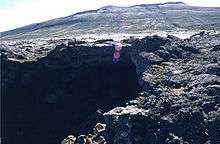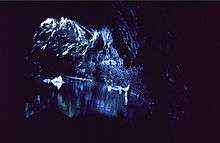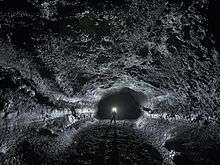Surtshellir
Surtshellir is a lava cave located in western Iceland, around 60 km from the settlement of Borgarnes. Approximately a mile in length, it is the longest such cave in the country. While mentioned in the medieval historical-geographical work Landnámabók, Eggert Ólafsson was the first to give a thorough documentation of the cave in his 1750 travels of the region.[1] It is named after the fire giant Surtr, a prominent figure in Norse mythology, who is prophesied to one day engulf the world in the fire of his flaming sword.[2][3]



Being of volcanic origin, the walls of the interior are composed of vitrified layers of magma and basalt.[4] The roof of the cave is about 10 metres high at the highest point, and the tunnels are around 15m broad at their greatest width.[5] The floor is covered in a perpetual sheeting of ice and fallen fragments of solidified lava, and large ice speleothems are common within the cave.[3] The height of the roof is highly variable throughout the cave, and at the latter extremities is only 2–4 m.[5]
In the 10th century, the cave and the passages that lead out from the main cavern were used as hideouts for outcasts and bandits who would steal livestock from the farmers and shepherds living in the area.[5] Evidence of their existence has been found in the form of the bones of sheep and oxen eaten for food in several of the tunnels;[1] one of the same tunnels had also been fitted with a human-made door.[4]
The cave itself has long been a source of superstition for the Icelanders inhabiting the nearby mountains. Eggert Ólafsson recalled having been warned by locals of the ghosts that were said to dwell within and was assured that his party would be killed by them if they were to enter. Surtr himself was said to have once lived within the cave and, being a fire giant, to have been the cause of the cave's creation.[1]
Surtshellir is in close proximity to another lava cave, Stefánshellir, with which it forms a complex referred to as the Surtshellir-Stefánshellir system.
Both caves were profusely decorated with lavacicles and lava stalagmites in the past, based on survey of the broken stubs and shattered pieces of these formations.[6] This has resulted from both deliberate vandalism from souvenir hunters and from high traffic through the caves with visitors bumping into and breaking the fragile formations. This is an unfortunate occurrence in many Icelandic caves.[6]
Notes
- Browne, George Forrest (1865). Ice-caves of France and Switzerland. Longmans, Green and co. pp. 244–6.
- Campbell, Thomas; Samuel Carter Hall (1858). New Monthly Magazine. p. 190.
- Leith, Disney (2008). Iceland. BiblioBazaar, LLC. pp. 59–62. ISBN 0-554-72053-1.
- Snelling, William Joseph (1831). The Polar Regions of the Western Continent Explored. W.W. Reed. pp. 24–5.
- Paijkull, Carl Wilhelm. A Summer in Iceland. Mordaunt Roger Barnard. Chapman and Hall. pp. 273–5.
- Stefánsson, Árni; Stefánsdóttr, Gunnhildur (May 2016). "Surtshellir in Hallmundarhraun". NSS News. 74 (5): 12–19.